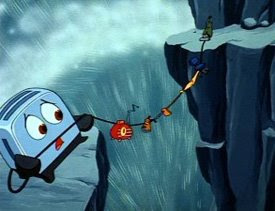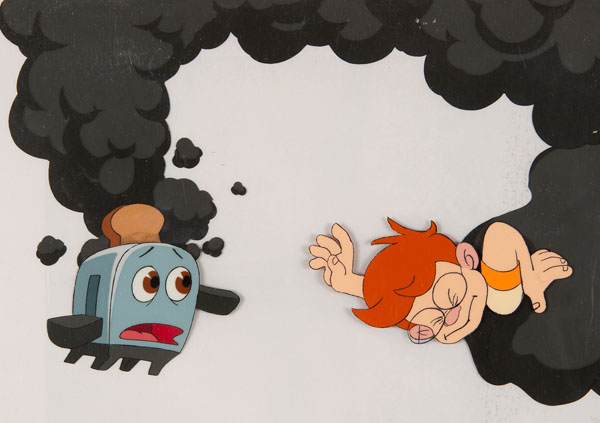
Who knew appliances could be so magical? It may not seem as compelling as what happens in Andy’s room when he’s not around in Toy Story or The Secret Life of Pets, but The Brave Little Toaster sheds a fantastical light on those workhorse household machines that get us through our day.
 The film focuses on the main character and his fellow anthropomorphic appliances: a radio, a lamp, and an electric blanket at a small cottage, who are waiting for a family, specifically a young boy named Rob (dubbed “Master”), to return for summer vacation.
The film focuses on the main character and his fellow anthropomorphic appliances: a radio, a lamp, and an electric blanket at a small cottage, who are waiting for a family, specifically a young boy named Rob (dubbed “Master”), to return for summer vacation.
When they all notice that the cottage has been put up for sale, the appliances head out on an adventure to find Rob for themselves.
The Brave Little Toaster is based on the 1980 novella by Thomas M. Disch, first appearing in Fantasy and Science Fiction Magazine. The Walt Disney Studios secured the rights in 1982, and a young animator named John Lasseter pitched it as a project for then-burgeoning computer animation. Unfortunately, it never moved forward.
Shortly after, the film’s production moved to Hyperion Pictures, a studio that former Disney employees initiated. Here, it would be an independent feature financed by Disney.
At the helm as director was Jerry Rees, who had started with Disney in 1978, mentored with members of Disney’s Nine Old Men, and worked on the visual effects for 1982’s landmark Tron. Rees brought a quality of classic Disney features to the proceedings, with his team of animators developing each of the appliances as distinct personalities (and employing comforting “squash and stretch” cartoony action to their movements).



Assisting with the character development in The Brave Little Toaster is a cast made up of veteran voice actors, writers, and comedians, such as Deanna Oliver as Toaster, Timothy E. Day as Blanky, Tim Stack as Lampy, John Lovitz as Radio, Wayne Kaatz as Master Rob, Joe Ranft, as the owner of an appliance parts shop, Thurl Ravenscroft as Kirby the vacuum and Phil Hartman, who voices an air conditioner in a great Jack Nicholson voice and provides the voice of a hanging lamp sounding like Peter Lorre.
 The film also featured four songs by noted songwriter Van Dyke Parks, all of which add compelling moments, mainly “It’s a B-Movie,” an eerie, shadowy moment where delipidated and patched-together items in the appliance shop sing to the main characters, in a sequence of perfect cartoon creepiness.
The film also featured four songs by noted songwriter Van Dyke Parks, all of which add compelling moments, mainly “It’s a B-Movie,” an eerie, shadowy moment where delipidated and patched-together items in the appliance shop sing to the main characters, in a sequence of perfect cartoon creepiness.
It’s one of the many darker moments in the film but also one of the highlights in The Brave Little Toaster. Another involves the interaction with Hartman’s Nicholson-sounding air conditioner, who freaks out, realizing that his life is all about being stuck in the window, and a sad and off-putting moment when all the appliances find themselves at the junkyard.
The Brave Little Toaster had its premiere at Wadsworth Theater in Los Angeles on July 13, 1987 and was also part of the 1987 Sundance Film Festival. It premiered on The Disney Channel on February 27th, 1988.
The generation who grew up with it on The Disney Channel, and those who enjoyed it on the festival circuit, helped The Brave Little Toaster develop a following through the years. The film is also noted for the number of talented artists who worked on it, such as Glen Keane, Kirk Wise, and Kevin Lima, just to name a few, that would go on to be significant players in the animation renaissance at the Disney studio in the 1990s.
The film proved popular enough to inspire two direct-to-video sequels, The Brave Little Toaster to the Rescue (1997) and The Brave Little Toaster Goes to Mars (1998).
More than these sequels and its cult-following, thirty-five years later, The Brave Little Toaster is noteworthy as an animated film made at the precipice of that blockbuster animation renaissance, when animators found creative ways to express themselves, expand the medium, and explore new realms, including magical appliances.



 Michael Lyons is a freelance writer, specializing in film, television, and pop culture. He is the author of the book, Drawn to Greatness: Disney’s Animation Renaissance, which chronicles the amazing growth at the Disney animation studio in the 1990s. In addition to Animation Scoop and Cartoon Research, he has contributed to Remind Magazine, Cinefantastique, Animation World Network and Disney Magazine. He also writes a blog, Screen Saver: A Retro Review of TV Shows and Movies of Yesteryear and his interviews with a number of animation legends have been featured in several volumes of the books, Walt’s People. You can visit Michael’s web site Words From Lyons at:
Michael Lyons is a freelance writer, specializing in film, television, and pop culture. He is the author of the book, Drawn to Greatness: Disney’s Animation Renaissance, which chronicles the amazing growth at the Disney animation studio in the 1990s. In addition to Animation Scoop and Cartoon Research, he has contributed to Remind Magazine, Cinefantastique, Animation World Network and Disney Magazine. He also writes a blog, Screen Saver: A Retro Review of TV Shows and Movies of Yesteryear and his interviews with a number of animation legends have been featured in several volumes of the books, Walt’s People. You can visit Michael’s web site Words From Lyons at: 






















Looking back at it now, Brave Little Toaster plays like a proto-Pixar film – no coincidence that Lasetter and Ranft, who were the major creatives at Pixar for its early features, were involved in its creation. Along with the general concept of inanimate objects come to life, there’s the rich characterization of not only the main cast, but also its minor characters. Each appliance is given a personality matching its function and their relationship with the Master. There are also moments of great emotion and suspense, not unlike those in the best Pixar films. (the junkyard scene is almost as harrowing as the one in Toy Story 3.) And the excellent score by David Newman (cousin of Pixar favorite Randy Newman and brother of Thomas Newman, who scored Finding Nemo and Wall-E) gives the story great dramatic heft.
This was the first animated feature I worked on, and I made a home movie documentary of my experience. https://www.youtube.com/watch?v=hflBh45HSoY&t=367s
Fascinating video, thanks for sharing! Always love seeing overseas animation studio footage. While some names of the Cuckoo’s Nest artists who worked on it would’ve been nice, we do get a name drop of at least one- Sparky Chen, I assume.
Thank you and I agree. I was just relying on my memory and the Americans were the ones I knew best, and so many of them went on to create important works in their later carreers, I thought it was worthwhile to identify them. I wish I could remember the names of the local artists.
Thank you for this. I loved it on The Disney Channel. One of the 1st animated movies I took the time to track down for my VHS (way back when), then on DVD. You made my day!
With all due respect for the talents of everyone who contributed to “The Brave Little Toaster”, there’s something wrong with an animated musical whose first song — a song, mind you, about starting out on a journey — doesn’t even begin until over twenty minutes into the picture. Compare Disney’s “Encanto”, whose opening number establishes the setting, introduces the characters, and explains the premise all in the first five minutes.
“The Brave Little Toaster” starts with a song; the Radio plays “Tutti Frutti” as the appliances clean. It wasn’t written for the film, but it is a nice peppy song which could catch an audience’s attention. While the song itself has little to do with the movie, the sequence introduces the characters & situation fairly well, & it is the sort of song one might listen to when waking up & cleaning house.
Consider that different movies have different pacing and intent. TBLT has a few lyrical songs in it, sure, but that doesn’t mean it has to have a big happy number five minutes in to establish the characters when it already did that from the start without song. This isn’t an upbeat movie just because it’s animated; hell, look at the other 3/4 of the songs in it.
As one of those kids who initially watched The Brave Little Toaster on Disney channel back in the 90s, this was an enjoyable revisit. The junkyard scene certainly is just as intense as I remember it, especially with the shades of red.
I wish The Brave Little Toaster would be released on blu-ray!!
Toy Story before Toy Story. But it wasn’t 3D, so less people cared.
Virtually nothing was 3D in 1987, come on. The reason the movie didn’t get enough attention was because Disney massively bungled the distribution (the VHS and especially the DVD are poor-quality film transfers) and never gave it a mainstream theatrical release.
I love 2D as much as the next person, but I’m sick of the constant putting-down of 3D every time when it has no relevance to the topic. Some movies work well in that medium and some don’t, it’s not inherently good or bad.
Speaking as someone who owned The Brave Little Toaster on VHS as a kid and eventually got it on DVD, I was a big fan of the movie growing up, and even now, I still love it. From what I gathered about it, the behind the scenes making of it was just as fascinating as the final product itself. It deserves more recognition for, among other things, serving as a starting point for many famous animators and directors, though I’m pretty sure Glen Keane wasn’t one of them.